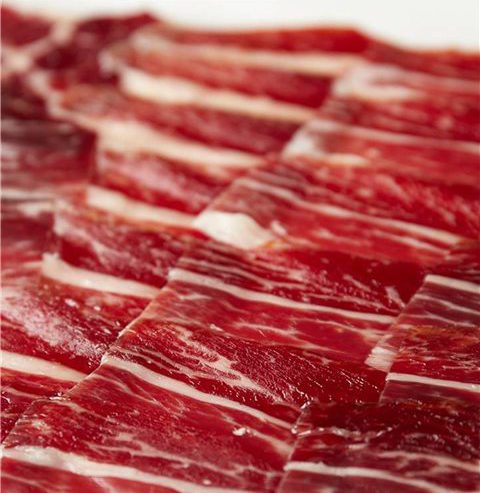
- Readers Rating
- No Rating Yet!
- Your Rating
Iberian ham is a food that we all like, for its high quality and exquisite flavour. However, it is difficult to differentiate between the different types without prior knowledge, so in this blog article we bring you the types and the differences!
Serrano ham or Iberian ham?
The first thing to know is the difference between Iberian and Serrano ham. The main differences between both hams lie in the breed and breeding conditions:
- Breed: Iberian ham is made from the Iberian breed, native to the Iberian Peninsula, while Serrano ham is made from white pigs of the Landrace (Denmark), Large White (England) or Duroc (USA) breeds.
- Feeding: Iberian pigs are reared in the wild in dehesas during the montanera, feeding on acorns and natural resources. In contrast to Serrano ham, whose pigs are raised on farms and fed on fodder and cereals.
- Curing: the ham undergoes a process of salting and subsequent drying in cellars or drying sheds. In this case, Iberian ham has a longer curing process than Serrano ham, due to its greater fat infiltration.
All these different ham-raising processes is what gives rise to the different flavour and texture of both types of ham. Iberico ham has a more intense, deeper and juicier flavour, due to its fat and its diet of acorns, as well as a juicier texture. However, Serrano ham has a less intense and saltier flavour, with a more fibrous texture. Therefore, the differences between them are appreciable both in the breed, the diet and the curing process.

Now, once the differences are known, it is necessary to know what types exist. Before starting, it is important to know that the montanera season is the last phase of Iberian pig rearing. It consists of letting the pigs roam freely in the pasture, in order to reach the traditional fattening. At this stage they feed on acorns and only pigs that have completed the previous stages can enter this stage.
According to breeding and feeding
Depending on the quality of the breed of the Iberian pig and its type of feed, we can distinguish the 3 best known types:
- Acorn fed Iberian ham: the highest quality. It comes from Iberian pigs reared in the wild in dehesas, which are fed on acorns and grass during the montanera season. With an intense flavour and characteristic infiltrated fat.
- Iberian Cebo de campo ham: also comes from Iberian pigs reared free-range in extensive dehesas. It is fed on grass, pasture and natural feed, without reaching the “montanera” phase. It has an exquisite flavour, but less intense than acorn-fed Iberico ham.
- Iberian Cebo ham: unlike the previous ones, the Iberian pig is reared on intensive farms. Its feed is based on fodder and cereals, so its quality is inferior. However, it is still a rich and more affordable ham.
According to the quality and purity of the breed
There are other types of classifications based on the quality and purity of the Iberian pig breed, which are very important when determining the quality of the ham. Among them, we highlight the following:
- 100% acorn-fed Iberian ham: the ham of excellent quality, as it comes from 100% Iberian pigs that have been reared in the wild, and whose feed is based on acorns and natural resources during the “montanera”.
- Acorn-fed Iberian ham o Pata Negra Ham: this is obtained from Iberian pigs that have been fed on acorns in the open range. The only difference is that these pigs may have a lower percentage of Iberian purity, as they have been crossed with other breeds.
- 100% Iberian Cebo de Campo ham: this category corresponds to hams from 100% Iberian pigs that have been reared in dehesas, and fed on pasture or natural resources.
- 100% Iberian Cebo ham: hams from 100% Iberian pigs that have been reared on farms and fed on fodder and cereals.
Ham labelling
Ham classifications vary depending on the producing country. In the case of Spain, a classification is carried out based on coloured labels and enumerations. The labels you should know are:
- Black label: guarantees that the ham is 100% Iberian, without crossbreeding and fed on acorns during the montanera.
- Red label: guarantees Iberian hams of 50%-75% purity, with a diet based on acorns from the dehesas and natural pastures.
- Green label: Iberian pigs reared in the field and fed on feed and natural pasture, which can have a purity of 100%, 75% or 50%.
- White label: Iberian cebo hams. They can be 100%, 75% or 50% Iberian breed, but they are fed on feed and legumes in fattening and breeding farms.
Differentiating the slices
How is it possible to tell the difference between the slices of Pata Negra Ham and fattened Iberico ham? Both hams have many similarities in terms of appearance, but there are certain aspects that help to differentiate them:
- Fat: acorn-fed ham has more fat infiltration due to its acorn-based diet. This means that the fat is more yellowish and softer to the touch, while Iberian ham has less fat and is whiter in colour.
- Meat: the meat of acorn-fed Iberian ham is usually darker and shinier, thanks to the acorns and natural resources it is fed on during the “montanera”. On the other hand, the meat of Iberian ham from cebo pigs has a lighter colour and is less marbled.
- Flavour and aroma: acorn-fed Spanish ham has a more intense and complex aroma, which provides the characteristic nuances of this type of ham. Cebo Iberian ham also has a characteristic flavour, but less intense than acorn-fed Iberico ham.
It is always advisable to look at the labelling and the characteristics of the product to know what you are buying. If you liked this information, you can consult our article on the differences between bacon, bacon and bacon, take note!
